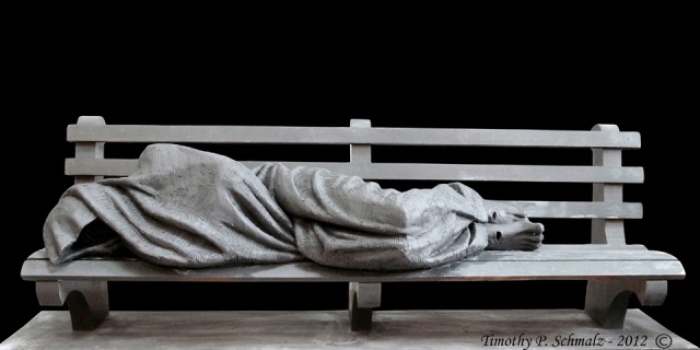Sculptor's 'Jesus the Homeless' Challenges Christians to Follow Gospel of Matthew

Canadian sculptor Timothy Schmalz says he created "Jesus the Homeless" to remind Christians that Jesus is with everyone, especially those who are marginalized in society – the poor and the homeless.
Featuring Jesus as a homeless person is a sharp contrast to the images of Christ that Christians are accustomed to seeing: Mary holding the infant Jesus, Jesus as a shepherd carrying a sheep and Jesus at the last supper.
According to Schmalz, there has been a 2,000-year blind spot in the art world, which has neglected to create a representation of Jesus' spoken words in the Gospel of Matthew 25. He told The Christian Post that he perceives his work as a visual translation of the Gospel. "A translation of one of the most important messages Christ gave to us."
The sculpture shows Christ's body shrouded in a blanket, lying on a 7-foot long park bench, and the only indication that the homeless person is Jesus is the visible wounds on the feet. The life-size version of the work, which is located outside Regis College at the University of Toronto in Ontario, Canada, has enough room for someone to sit on the bench.
Schmalz said he's hoping to get requests from other cities or churches that want to display the sculpture in a visible location where millions of people will see it.
Even though Christians are not comfortable seeing Jesus portrayed as a homeless person, Schmalz said he wants that representation of him, and spoke of the sculpture's "haunting realism," and the power that art has to connect with people.
"The son of man is represented in one of the most authentic ways," he said about the sculpture's ability to proclaim the truth of Jesus Christ.
Schmalz came up with the idea to depict Jesus as a homeless person during the 2011 Friends of the Crèche international art show at the Royal York in Toronto where he featured his nativity piece "Joy to the World." In the evening, he and his friend and manager, Tony Frey, stepped out to have dinner. During their long walk to find a restaurant that served meals under $50 a plate, they passed by many homeless people on the streets.
One homeless man, in particular, captured his attention and Schmalz said to himself: "That is Jesus. That is how we should perceive the least among us in our heart."
"Something about this homeless person just jolted me," he explained. "The whole time, in-and-out of the city, that image and those words were completely present with me at that time."
Frey told CP that during their supper that night in Toronto, Schmalz shared his idea for the piece. "Tim used to live in Toronto," Frey said, "and now he's a country boy living north of Waterloo. Living in the country, you're not exposed to seeing homeless people on the streets."

"It hit him, the epidemic," Frey continued. "It's not often that you create a sculpture without a commission – you need a patron because of the cost. This was one of those pieces Tim was moved to create without having a home for it. It's providential," because of the global economic problems Europe and North America are facing.
Despite the sculpture's message – Jesus identifying with the poorest among us – it was rejected by two prominent Catholic churches, St. Michael's Cathedral in Toronto and St. Patrick's Cathedral in New York.
Schmalz said he went to those two churches because millions of people see the cathedrals and he believed they would be the best locations to feature the three-dimensional sermon.
He received positive responses from the church rectors and was even show the prominent locations where the sculpture would be featured at each church. At St. Patrick's, the sculpture was to be placed in front of the steps just outside the cathedral. But one month after the meetings, Schmalz was told that the decision was made not to include his sculpture.
"It just baffled and bewildered me," he said. "As a Christian, I didn't get angry, I was just sad."
Frey commented that he would like to see the sculpture sitting next to the bronze bull on Wall Street in New York City, "but that's not going to happen." He added that although people are not used to seeing the bare truth depicted to them, the sculpture of Jesus the Homeless is "impossible not to understand."
"This is not shocking art," Frey added. "It's not a post-modern attempt like putting elephant dung on the Virgin Mary. The sculpture challenges us. And in that challenge you are shaken, for a moment, and you realize it was good to be shaken."
Schmalz described his piece as a sermon proclaiming that we should see Jesus when we see the most marginalized people in our community. "That's how Jesus wants to be perceived – when you fed the hungry, clothed the naked, you did that to me (Matthew 25:35-40). Essentially doing with the sculpture what Jesus is doing with his words."
When he lived in Toronto as a young artist, Schmalz was almost homeless. He lived in a 10 x 20 studio, had no heat and slept on a wood board, and thus has a keen understanding of their experience. Schmalz said he feels the sculpture's success will be achieved if people are brought into the same space he was in when he saw the homeless on the streets of Toronto.
Schmalz added that he believes society is lacking a spiritual connection to the sacredness of all life, and the sculpture exists to remind Christians that Jesus didn't spend his time on earth with kings, but with the poor.
"That is one thing about Christianity," he said, "is that our God doesn't hang out with other kings, he is among the poor, the marginalized and prostitutes."
Schmalz explained that even though many North Americans are suffering, people can walk the streets of Toronto and see massive multi-million dollar condos. "And at the foot of these buildings are the human beings who don't have enough to eat. Society is not lacking money," he said. "We put our self-worth in money. Jesus was with the poor, and that means everyone is sacred."
His hope is that homeless people will regain some of their self-dignity when they see the sculpture of Jesus, and feel comforted by him.
The dedication ceremony for the sculpture was held at the University of Toronto two weeks ago, and Schmalz said he's very happy that Jesus finally found a home in Toronto, and on one of the city's busiest streets, where the sculpture's message will be received by millions.
Schmalz wants to see the sculpture featured in large cities throughout the world where people are struggling financially. "The message is eternal," he said. "In 2013 this is the perfect message for all to see."






























